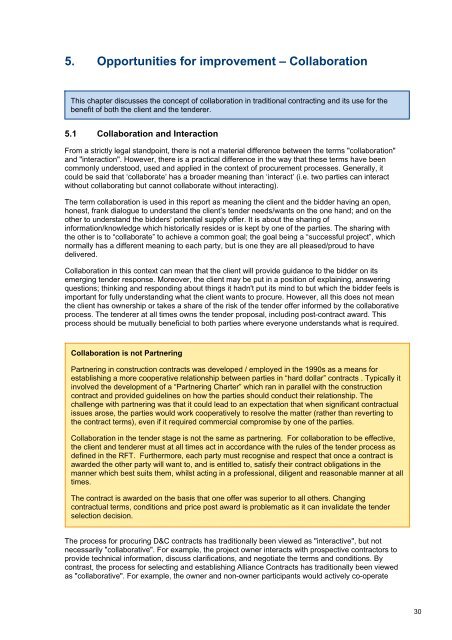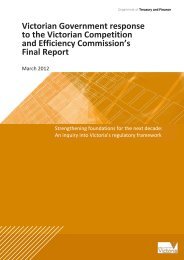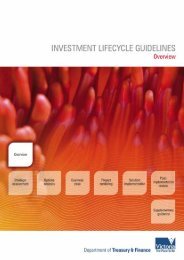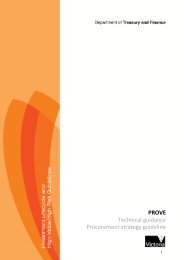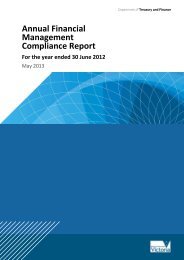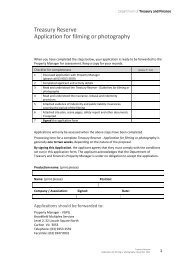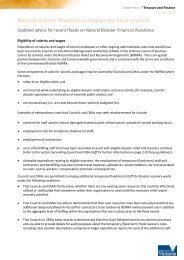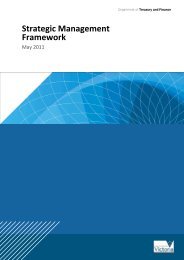Towards Agreed Expectations - Department of Treasury and Finance
Towards Agreed Expectations - Department of Treasury and Finance
Towards Agreed Expectations - Department of Treasury and Finance
You also want an ePaper? Increase the reach of your titles
YUMPU automatically turns print PDFs into web optimized ePapers that Google loves.
5. Opportunities for improvement – CollaborationThis chapter discusses the concept <strong>of</strong> collaboration in traditional contracting <strong>and</strong> its use for thebenefit <strong>of</strong> both the client <strong>and</strong> the tenderer.5.1 Collaboration <strong>and</strong> InteractionFrom a strictly legal st<strong>and</strong>point, there is not a material difference between the terms "collaboration"<strong>and</strong> "interaction". However, there is a practical difference in the way that these terms have beencommonly understood, used <strong>and</strong> applied in the context <strong>of</strong> procurement processes. Generally, itcould be said that ‘collaborate’ has a broader meaning than ‘interact’ (i.e. two parties can interactwithout collaborating but cannot collaborate without interacting).The term collaboration is used in this report as meaning the client <strong>and</strong> the bidder having an open,honest, frank dialogue to underst<strong>and</strong> the client’s tender needs/wants on the one h<strong>and</strong>; <strong>and</strong> on theother to underst<strong>and</strong> the bidders’ potential supply <strong>of</strong>fer. It is about the sharing <strong>of</strong>information/knowledge which historically resides or is kept by one <strong>of</strong> the parties. The sharing withthe other is to “collaborate” to achieve a common goal; the goal being a “successful project”, whichnormally has a different meaning to each party, but is one they are all pleased/proud to havedelivered.Collaboration in this context can mean that the client will provide guidance to the bidder on itsemerging tender response. Moreover, the client may be put in a position <strong>of</strong> explaining, answeringquestions; thinking <strong>and</strong> responding about things it hadn't put its mind to but which the bidder feels isimportant for fully underst<strong>and</strong>ing what the client wants to procure. However, all this does not meanthe client has ownership or takes a share <strong>of</strong> the risk <strong>of</strong> the tender <strong>of</strong>fer informed by the collaborativeprocess. The tenderer at all times owns the tender proposal, including post-contract award. Thisprocess should be mutually beneficial to both parties where everyone underst<strong>and</strong>s what is required.Collaboration is not PartneringPartnering in construction contracts was developed / employed in the 1990s as a means forestablishing a more cooperative relationship between parties in “hard dollar” contracts . Typically itinvolved the development <strong>of</strong> a “Partnering Charter” which ran in parallel with the constructioncontract <strong>and</strong> provided guidelines on how the parties should conduct their relationship. Thechallenge with partnering was that it could lead to an expectation that when significant contractualissues arose, the parties would work cooperatively to resolve the matter (rather than reverting tothe contract terms), even if it required commercial compromise by one <strong>of</strong> the parties.Collaboration in the tender stage is not the same as partnering. For collaboration to be effective,the client <strong>and</strong> tenderer must at all times act in accordance with the rules <strong>of</strong> the tender process asdefined in the RFT. Furthermore, each party must recognise <strong>and</strong> respect that once a contract isawarded the other party will want to, <strong>and</strong> is entitled to, satisfy their contract obligations in themanner which best suits them, whilst acting in a pr<strong>of</strong>essional, diligent <strong>and</strong> reasonable manner at alltimes.The contract is awarded on the basis that one <strong>of</strong>fer was superior to all others. Changingcontractual terms, conditions <strong>and</strong> price post award is problematic as it can invalidate the tenderselection decision.The process for procuring D&C contracts has traditionally been viewed as "interactive", but notnecessarily "collaborative". For example, the project owner interacts with prospective contractors toprovide technical information, discuss clarifications, <strong>and</strong> negotiate the terms <strong>and</strong> conditions. Bycontrast, the process for selecting <strong>and</strong> establishing Alliance Contracts has traditionally been viewedas "collaborative". For example, the owner <strong>and</strong> non-owner participants would actively co-operate30


